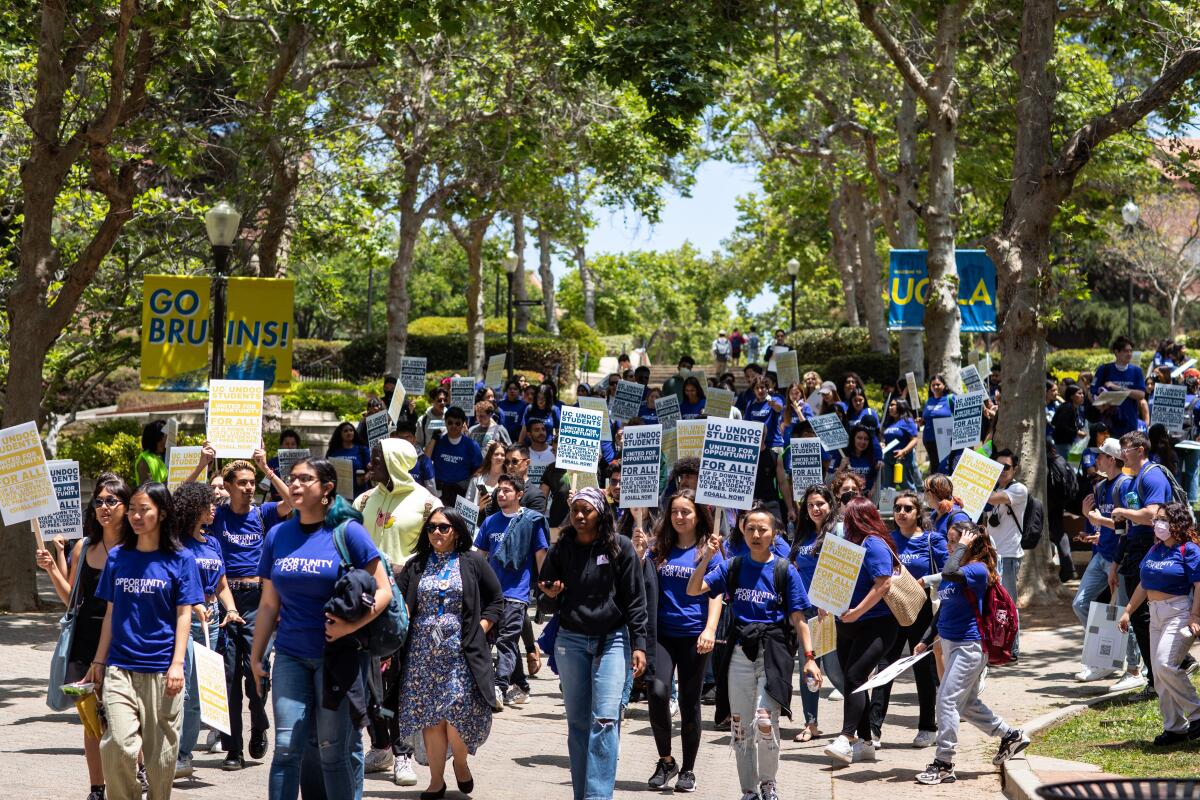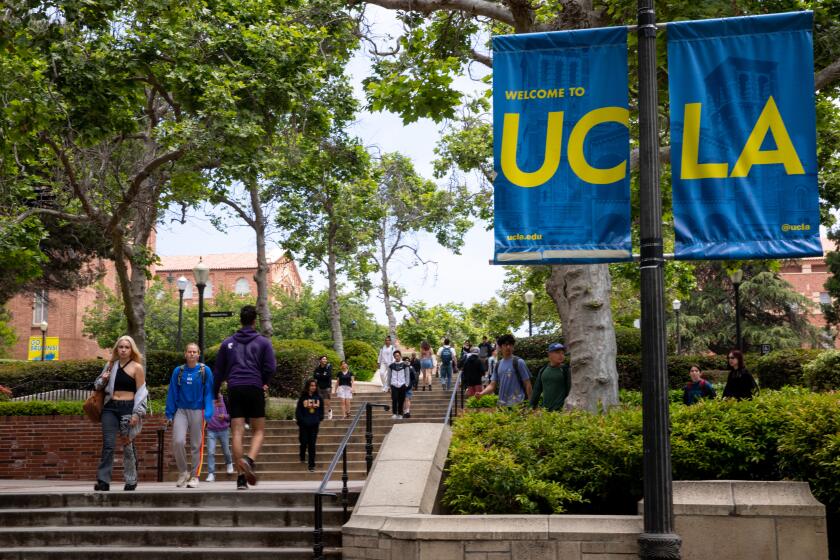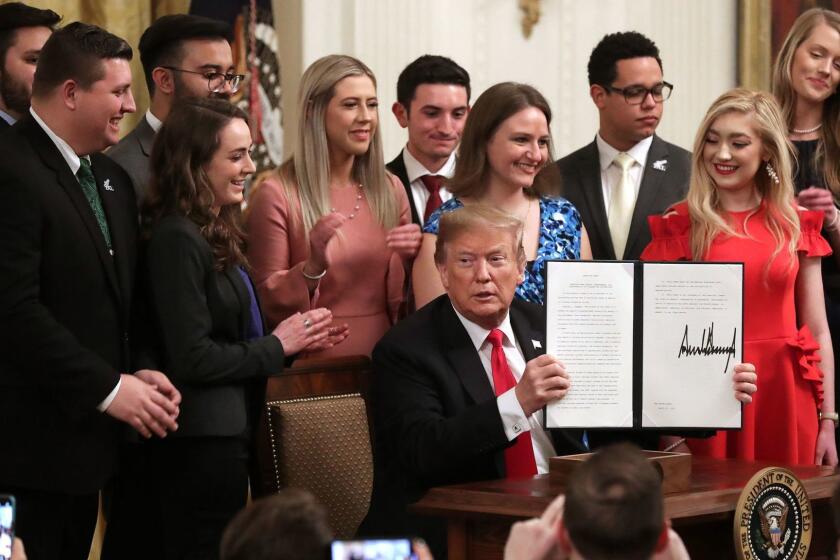Opinion: College students were ‘woke’ in the ’60s, annoying to elders and drivers of social change. Meet their successors

- Share via
What would it be this time, I wondered, as the protesting students rushed into my office a few years ago at Wesleyan University. More trigger warnings or calls to cancel a speaker?
I’ve been well aware that students are accused of enforcing political conformity with social ostracism while avoiding hard questions about their own (progressive) pieties. Conservatives have for decades complained about protests and student demands, but today even liberals join in, unhappy to have found themselves the targets of student objections to the language they use, or their blindness to their own privilege.
I joked with the protesters, asking them why they weren’t waiting for my regular office hours. One pulled out an old campus newspaper article showing me, then a junior at the university, among those occupying the president’s office some 30 years before. Well played, I admitted, as they presented their demands. Some of their ideas, like reducing our carbon footprint, turned out to be quite sensible. Others, like boycotting groups that had any connection to Israel, seemed to me misguided. We worked through our differences in engaged conversation. We all learned something.
Recent incidents at SUNY Albany, Stanford Law School and Cornell show students confusing censorship for legitimate protest.
There is a long history of student protest in this country. And today’s demands from students for greater diversity and inclusion — among the faculty, in admissions and in what’s taught in the classroom — fall within that tradition. Back in the day, students raised their voices against apartheid and more recently have demanded concrete action to deal with the climate emergency. Students have pushed higher education to live up to the ideals we claim to espouse, and in so doing they have learned how to constructively respond to political differences beyond the campus.
And they have pushed for a long time! Even in the Colonial period young people complained of the dictatorial tendencies of academic authorities, linking them with the tyrannical British. Some years later, Thomas Jefferson tried to provide students at his new University of Virginia with more intellectual autonomy, allowing them to choose classes. But the students there had other liberties in mind and rioted for more freedom from college supervision. Undergrads at women’s colleges in the 20th century made similar demands for personal autonomy and student self-governance.
Even without the burden of ‘colorblind’ admissions policies, equalizing opportunities for South L.A. students required their perseverance and intensive support.
The iconic image of student protest, of course, is not that of undergraduates seeking later curfews or less supervision. It’s of young people in the 1960s spurning the world of their parents. At a time of civil rights battles and the acceleration of the war in Vietnam, students rejected the idea that campuses should be separate from society and embraced the principle that their political action mattered.
The Free Speech Movement at UC Berkeley was created not just to defend students’ rights to express themselves but to challenge the framework of a society that offered what its most famous leader, Mario Savio, called a sick “utopia of sterilized automated contentment.” The movement engaged in civil disobedience to stop the evils produced by “the System.” Their aim was to awaken people to society’s injustices and the possibilities for radical change.
Of course, many older people found this annoyingly self-righteous — what many today would call performative. More seasoned political folks — even liberals — scoffed at the combination of naivete and hubris. Older generations struggled to understand why so many of those fortunate enough to be in college were turning their backs on the opportunities they were given, while the young were incredulous that their calls for change were falling on deaf ears.

We see this dynamic replayed today as students demand that colleges address systemic racism within the institutions themselves, including examining their history, the structure of higher education and the question of who has access to these institutions. Not surprisingly, such demands can at times provoke a familiar response from older people — that concerns even for things like equity and debt relief are disconnected from “ordinary Americans.”
Now that the Supreme Court has struck down affirmative action, elite schools should recruit from a neglected pipeline: transfer students from community colleges.
When conservatives denounce campus progressives and radicals as out-of-touch elites, when liberals bemoan failures to defend free speech, and when both denounce cancel culture, one can hear the echoes of the 1960s.
Young people today are accused of being censorious, illiberal and careerist — as well as “woke.” This is all part of the long, cliche-ridden history of accusing the young of failing to live up to an older generation’s idea of the student.
Founding Fathers complained about drinking in the dorms; in the 1960s musical “Bye Bye Birdie,” parents sang, “What’s the matter with kids today?” Today, we hear about coddled minds afraid of discomfort and challenge.
A key section of President Trump’s latest executive order, issued Thursday, aims to protect free speech on campus.
Student protesters and those complaining about them actually have something fundamental in common. They agree that college should be a time of possibilities as one learns to think for oneself in the company of others. They share the notion that being a student is ideally about learning freedom.
There will, of course, be different views on what it means to exercise that freedom. Students questioning obstacles and opportunities have long experienced pushback from those defending the status quo — and they’ve learned from that too.
And that’s what campus protests have always been about: young people experimenting with the expectations and limits surrounding them as they try to think for themselves in the context of community. I’ll try to remember that next time they come barging into my office. Maybe we’ll all learn something.
Michael S. Roth is the president of Wesleyan University and the author of “The Student: A Short History,” which will be published on Sept. 12.
More to Read
A cure for the common opinion
Get thought-provoking perspectives with our weekly newsletter.
You may occasionally receive promotional content from the Los Angeles Times.














